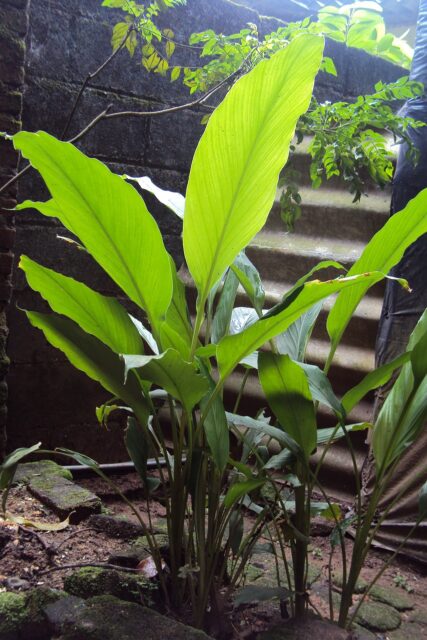Are ginger leaves edible? Yes, ginger leaves are edible. They have a more delicate ginger flavor, making them ideal for only wanting a hint of flavor. However, ginger leaves can be somewhat fibrous.
In this essay, we will look at ginger leaves’ edibility and potential culinary applications. Understanding whether ginger leaves are safe to eat and how to cook them allows you to expand your culinary expertise.
Are ginger leaves edible?
Ginger leaves are edible, however, they can be fibrous, so consider heating or preparing them before eating. Ginger leaves have a grassy, vegetal and spicy flavor that can enhance fresh and cooked dishes.
Edibility of Ginger Leaves
Ginger leaves are edible, albeit they may be fibrous. Despite their fibrous nature, ginger leaves have a variety of uses.
Here are several ways to make the most of ginger leaves.
- Ginger leaves can be added to stir-fries, soups and curries. They impart a distinct flavor and scent to foods.
- Ginger leaves contain chemicals with antioxidant and anti-inflammatory effects. Consuming ginger leaves can improve overall health.
- Ginger Leaf Recipes: To make ginger leaf tea, steep the leaves in boiling water. They can also be used as a wrap to steam fish or vegetables, imparting a slight ginger taste.
- Alternative uses: Ginger leaves can serve as a natural insect repellant. Simply crush the leaves and use them on your skin to repel mosquitoes.
- To keep ginger leaves fresh, store them in the refrigerator, wrapped in a moist paper towel.
Nutritional Value of Ginger Leaves
The nutritional value of ginger leaves is worth investigating for potential health advantages.
Ginger leaves have a high nutritional value, including vital elements including vitamins C, A, and K. They also supply minerals such as potassium, calcium and iron.
These leaves can be used in a variety of cooking methods, including stir-frying, steaming and as a garnish in soups and salads. Ginger leaf recipes are popular in many culinary traditions, as they impart a distinct flavor and aroma to meals.
Aside from their culinary use, ginger leaves are known for their therapeutic benefits. They have been utilized in traditional medicine because of their anti-inflammatory, antioxidant and digestive properties.
Ginger leaves are a nutritious and flavorful complement to your meals, providing both taste and potential health benefits.
How to Prepare and Cook Ginger Leaves
Ginger leaves can be readily prepared and cooked into your favorite meals.
Here are some options for discovering the flavor profiles, traditions, remedies and sustainability of using ginger leaves in your cooking:
- Ginger leaves have a unique, spicy flavor with notes of citrus and earthiness. Experiment with other combinations, such as adding garlic and soy sauce to a savory stir-fry or infusing them in a refreshing ginger and mint tea.
- Creative Recipes: Get creative by using ginger leaves in recipes like ginger leaf pesto, which can be made with these tasty leaves instead of typical basil. You may also add them to salads, soups, and sushi rolls for a unique flavor.
- IncorGinger leaves are commonly employed in a variety of culinary cultures. For example, in Thai cuisine, they are frequently used to enhance the flavor of curries and soups. In Indian cuisine, ginger leaves are used to wrap and steam fish or chicken, infusing them with aromatic tastes.
- Herbal remedies: Ginger leaves have long been known for their therapeutic benefits. They are known to improve digestion, reduce inflammation, and enhance the immune system. Investigate traditional therapies such as ginger leaf tea or include them in herbal infusions for their medicinal properties.
- Sustainability: Using ginger leaves in cooking can help with sustainability initiatives. We reduce waste and maximize the value of the ginger plant by using all of its parts, including the leaves. Growing ginger at home is also more sustainable, as it reduces transportation emissions and promotes self-sufficiency.
Incorporating ginger leaves into your cooking not only adds unusual flavors but also ties you to culinary traditions, may provide health advantages and encourages sustainability. So, get creative with ginger leaves in your cooking!
Potential Risks and Precautions for Consuming Ginger Leaves
Consuming ginger leaves may provide hazards and precautions, which you should be aware of. While ginger leaves are generally considered safe to consume, some people may develop negative effects or allergic responses. It’s best to start with a tiny dosage and observe your body’s reaction.
If you have any adverse reactions, such as stomach discomfort, rashes, or difficulty breathing, stop using the product immediately and seek medical treatment.
Furthermore, ginger leaves should be used sparingly and at the recommended dosage.
Excessive drinking may cause stomach problems or interact with certain drugs. When cooking ginger leaves, make sure they’ve been well washed to remove dirt and pesticides.
It’s also worth noting that ginger leaves can be utilized for a variety of reasons, including creating tea and treating numerous ailments naturally.
Always consult with a healthcare practitioner before introducing ginger leaves into your diet to verify they are safe for your specific needs.
How to Store Ginger Leaves
As previously said, ginger leaves are best eaten fresh. Fresh ginger leaves have milder qualities than ginger rhizome, so utilizing them helps to enhance both flavor and scent.
Of course, it is not always possible to pluck a few ginger leaves and use them right away.
So, here are several choices that will allow you to include the ginger leaves at any time:
As with other soft herbs, finely chopped ginger leaves can be frozen. Fill ice cubes with chopped ginger leaves and cover with water. Once frozen, put the ginger leaves in freezer bags to use in stews, soups or smoothies as needed. They do not need to be defrosted before use.
Chopped ginger leaves can be preserved in a dehydrator (or low oven) alongside regular tea leaves and herbs. Dried ginger leaves can be used as tea on their own or combined with other ingredients in your cooking.
How To Include Ginger Leaves In Your Diet
If you want to add ginger leaves to your diet, now is the time to learn about their different flavors and potential health advantages.
One approach to incorporating ginger leaves is to mix them into your smoothies. Simply combine the leaves with your favorite fruits and veggies for an extra burst of flavor and nutrition.
Another approach is to include ginger leaves in salads. Chop them up and combine with your greens for a refreshing and aromatic twist.
If you’re feeling daring, you can even make ginger leaf-infused oils or seasoning blends. These can be used to lend a bit of ginger flavor to your recipes.
Finally, consider creating ginger leaf pesto. Combine the leaves with garlic, almonds, and olive oil to make a wonderful and adaptable sauce.
With these options, you can simply add ginger leaves to your diet while enjoying their distinct flavor and potential health advantages.
Benefits of Growing Your Ginger
There are several reasons to grow your ginger. For instance, while ginger rhizomes are now widely available in the vegetable department of most supermarkets, many people are still unaware of ginger leaves. This implies that they can be difficult to come by.
Ginger leaves are best consumed fresh. If you have your own ginger plant, use fresh ginger leaves within hours of picking to achieve optimum taste value.
The high quantities of antioxidants will not have dwindled while they lay on a shelf for extended durations.
If you are unable to use the ginger leaves immediately after picking them, store them in a plastic bag in the refrigerator.
Finally, growing your ginger allows you to control the chemicals utilized in its production. And if you, like me, prefer to produce and eat organic foods, you can be confident that your ginger and ginger leaves will be pesticide-free.
Frequently Asked Questions.
Are ginger leaves safe to consume raw?
Yes, ginger leaves are safe to consume raw. They provide nutritional value, culinary applications, and health benefits. You can include them in your diet by mixing them into salads or smoothies. Refrigerate them to maintain freshness.
Can Ginger Leaves Substitute for Ginger Root in Recipes?
Ginger leaves can be used as an alternative to ginger root in recipes. They have culinary applications, such as adding flavor to dishes and can be utilized in a variety of cooking procedures. They have a similar flavor characteristic to ginger root and can be stored for later use.
Can Ginger Leaves be Dried and Used as Spice?
Yes, ginger leaves can be dried and used as a seasoning. They have culinary applications in many cultures and have health advantages due to their nutritional content. To keep them, dry them and store them in an airtight container.
Conclusion
In conclusion, ginger leaves are edible and provide a variety of culinary and health benefits. These leaves are high in antioxidants, vitamins, and minerals, making them a healthy complement to any diet.
They can be used in a variety of recipes, such as stir-fries, salads and teas. However, it’s crucial to note that certain people may have allergies or digestive disorders, so eat ginger leaves in moderation and visit a doctor if necessary.
Incorporating ginger leaves into your meals can improve flavor and support overall health.


